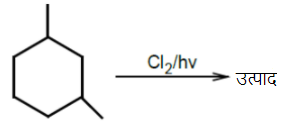The correct structure of 3,3-dimethyl butyne is:
1.
2.
3.
4. 
3,3-डाइमेथिल ब्यूटाइन की सही संरचना है:
1.
2.
3.
4. 


The monochlorinated products (excluding stereo-isomers) obtained from the reaction

1. 4
2. 5
3. 6
4. 7
अभिक्रिया से प्राप्त मोनोक्लोरीनीकृत उत्पाद (त्रिविम-समावयवी को छोड़कर) हैं:

1. 4
2. 5
3. 6
4. 7
The IUPAC name of the compound,
is:
1. 2-ethylbutanamide
2. 2-methylbutanamide
3. 1-amino-2-methylpropane
4. none of the above
यौगिक, 
1. 2-एथिलब्यूटेनैमाइड
2. 2-मेथिलब्यूटेनैमाइड
3. 1-एमीनो-2-मेथिलप्रोपेन
4. उपरोक्त में से कोई नहीं
What is decreasing order of basicity of 1°, 2° and 3° ethyl amines and ammonia?
(1) NH3>C2H5NH2>(C2H5)2NH>(C2H5)3N
(2) (C2H5)3N>(C2H5)2NH>C2H5NH2> NH3
(3) (C2H5)3NH>C2H5NH2>(C2H5)3N>NH3
(4) (C2H5)2NH>(C2H5)3N>C2H5NH2>NH3
1°, 2° और 3° एथिल एमीन और अमोनिया की क्षारकता का घटता क्रम क्या है?
1. NH3>C2H5NH2>(C2H5)2NH>(C2H5)3N
2. (C2H5)3N>(C2H5)2NH>C2H5NH2> NH3
3. (C2H5)3NH>C2H5NH2>(C2H5)3N>NH3
4. (C2H5)2NH>(C2H5)3N>C2H5NH2>NH3
The increasing order of +ve I-effect shown by H, CH3, C2H5 and C3H7 is:
(1) H < CH3 <C2H5 <C3H7
(2) H> CH3 <C2H5 > C3H7
(3) H< C2H5 <CH3 <C3H7
(4) none of the above
H,CH3,C2H5 और C3H7 द्वारा दर्शाये गए धनात्मक I प्रभाव का बढ़ता क्रम है:
1. H < CH3 <C2H5 <C3H7
2. H> CH3 <C2H5 > C3H7
3. H< C2H5 <CH3 <C3H7
4. उपरोक्त में से कोई नहीं
Which one of the following has the most acidic nature?
1. 
2. 
3. 
4. 
निम्नलिखित में से किसमें सबसे अधिक अम्लीय प्रकृति होती है?
1. 
2. 
3. 
4. 
The (R)- and (S)-enantiomers of an optically active compound differ in
(1) their solubility in a chiral solvent
(2) their reactivity with a chiral reagent
(3) their optical rotation of plane polarised light
(4) their melting points
एक प्रकाशिक सक्रिय यौगिक के (R)- और (S)-प्रतिबिंब रूपों में भिन्न है-
1. काइरल विलायक में उनकी विलेयता
2. एक काइरल अभिकर्मक के साथ उनकी अभिक्रियाशीलता
3. समतल ध्रुवित प्रकाश में उनका प्रकाशीय घूर्णन
4. उनके गलनांक
Which of the following statements is not correct for a nucleophile?
1. Nucleophile is a Lewis acid
2. Ammonia is a nucleophile
3. Nucleophiles attack low electrons density sites
4. Nucleophiles are not electron seeking
नाभिकरागी के लिए निम्नलिखित में से कौन सा कथन सही नहीं है?
1. नाभिकरागी एक लुईस अम्ल है
2. अमोनिया एक नाभिकरागी है
3. नाभिकरागी कम इलेक्ट्रॉन घनत्व वाले स्थानों पर हमला करते हैं
4. नाभिकरागी इलेक्ट्रॉन आकर्षी नहीं हैं
For the following :
(i) I-
(ii) Cl-
(iii) Br-
the increasing order of nucleophilicity would be :
1. I- < Br- < Cl-
2. Cl- < Br- < I-
3. I- < Cl- < Br-
4. Br- < Cl- < l-
निम्नलिखित के लिए :
(i) I-
(ii) Cl-
(iii) Br-
नाभिकरागिता का बढ़ता क्रम होगा:
1. I- < Br- < Cl-
2. Cl- < Br- < I-
3. I- < Cl- < Br-
4. Br- < Cl- < l-
Which one is the correct order of acidity?
1. CH2=CH2 > CH3-CH=CH2 > CH3C≡CH > CH≡CH
2. CH≡CH > CH3-C≡CH > CH2=CH2 > CH3 CH3
3. CH≡CH > CH2=CH2 > CH3-C≡CH > CH3-CH3
4. CH3-CH3 > CH2=CH2 > CH3-C≡CH > CH≡CH
अम्लता का सही क्रम कौन सा है?
1. CH2=CH2 > CH3-CH=CH2 > CH3C≡CH > CH≡CH
2. CH≡CH > CH3-C≡CH > CH2=CH2 > CH3 CH3
3. CH≡CH > CH2=CH2 > CH3-C≡CH > CH3-CH3
4. CH3-CH3 > CH2=CH2 > CH3-C≡CH > CH≡CH






